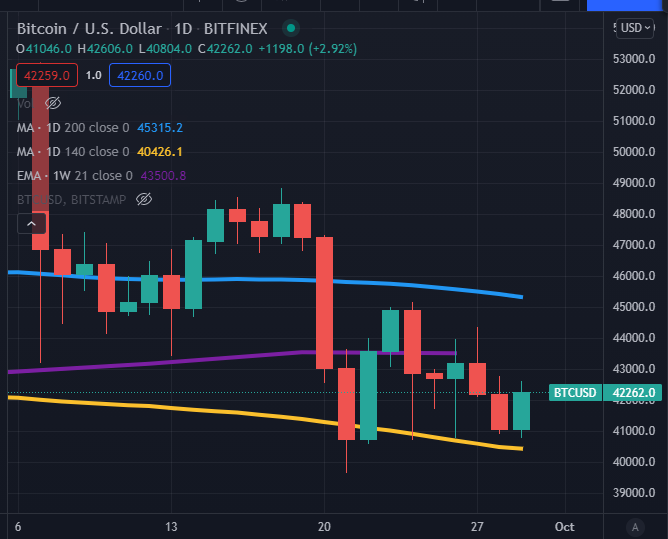How did the previous China crypto ban attempts affected Bitcoin’s price?
The effect of restricting cryptocurrency legislation by the Chinese government has been diminishing over the years.
In 2013 China banned the handling of BTC transactions, and the price dropped by 60%+.
In 2017 they banned issuing of ICOs and use of international crypto exchanges, and the price dropped by 40%+.
In 2019 they restricted bitcoin mining, which dropped the price by 30%+, and in May 2021 when they banned bitcoin mining altogether, the price also dropped by 30%.
The most recent china crypto ban only resulted in a BTC 8% dip, and the price after 2 days is already bouncing off the 140-day moving average. (yellow line on the chart below)

Does this ban impacts China-based investors?
Yes, the current ban will severely restrict the available options to Chinese to invest in crypto, which was primarily operated via centralized exchanges, payment providers, and other financial institutions. Now, all national and overseas exchanges are forced to pause and eventually disable all Chinese citizen’s accounts. In addition to the institutional crackdown, the assumed risk for Chinese investors is exponentially higher now since personal cryptocurrency transactions are no longer offered legal protection status.
Can the Chinese still invest in cryptocurrencies?
The only feasible ways to invest in cryptocurrencies are via decentralized exchanges, via decentralized Peer to Peer (P2P) marketplaces, via decentralized OTC platforms, or via direct trades. All of those options have, however, higher risk and possibility of errors or frauds. Chinese investors with offshore banking accounts may also have ways to invest via foreign financial institutions that are governed by more lenient legal jurisdictions. However, the majority of Chinese citizens will not have such an opportunity.
How does this ban impact the entire crypto ecosystem?
The ban will have a moderate short-term negative effect on the adoption of cryptocurrencies, but in the long run, it may facilitate more positive regulation and eventually adoption from competing nations, which will try to utilize their strategic advantage over China.
Will the China crypto ban affect the adoption of the Digital Yuan?
Yes, I believe that the introduction of the Digital Yuan is the primary motivation for the latest ban. The Chinese government will try to completely control and monitor the money flow and all financial transactions within their economy and smoothly transition all economic activities via their digital currency. Any other foreign currency, including cryptocurrencies, has limited traceability, directly undermining the Chinese digital currency’s operation.
Can this China crypto ban become an opportunity for the US?
Yes, the US has the opportunity to provide favorable legislation that will attract both funds and workforce from displaced Chinese cryptocurrency institutions, investors, miners, researchers, and developers.
How much of the crypto market is driven by China-based investors?
In general, there is very little information to reliably determine the trading or adoption activity of cryptocurrencies in China. Some of the most comprehensive adoption studies, such as the Statista crypto adoption study don’t have reliable information from China since the “Great firewall” blocks them.
The most reliable indicator in my opinion, is to track the OTC yuan/usdt volume from various exchanges and compare it with other OTC currencies volumes. Many OTC exchanges provide data of their pair volumes; however, there is no aggregated information for this statistic.
Conclusion
The new China crypto ban is unlikely to affect negatively the medium-long term prices of Bitcoin and the cryptocurrency market in general.
In fact, many investors are quite optimistics with the ban, since it helps decentralize more the distribution of bitcoin holdings and mining to more crypto-friendly nations.
See more daily cryptocurrency analysis here at the Daily Analysis blog .

